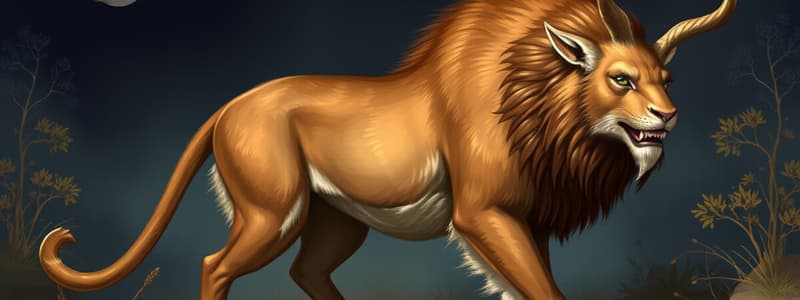Podcast
Questions and Answers
What are mammals classified under?
What are mammals classified under?
Kingdom: Animalia, Phylum: Chordata, Class: Mammalia
How many species of living mammals are there approximately?
How many species of living mammals are there approximately?
- 1,000
- 5,000 (correct)
- 10,000
- 20,000
Mammals nourish their young with milk produced in sweat glands.
Mammals nourish their young with milk produced in sweat glands.
True (A)
Name one order under the subclass Eutheria.
Name one order under the subclass Eutheria.
What does 'artiodactyl' refer to?
What does 'artiodactyl' refer to?
Which of these species belong to the order Carnivora?
Which of these species belong to the order Carnivora?
What is an example of a cetacean?
What is an example of a cetacean?
What is the largest land animal?
What is the largest land animal?
All members of the order Primates are herbivores.
All members of the order Primates are herbivores.
Which order do kangaroos belong to?
Which order do kangaroos belong to?
Match the following orders with their examples:
Match the following orders with their examples:
Flashcards are hidden until you start studying
Study Notes
Classification of Mammals
- Mammals belong to the Kingdom Animalia, Phylum Chordata, and Class Mammalia.
- Approximately 5,000 species of living mammals exist today.
- Characteristics of mammals include body hair, three middle ear bones (malleus, incus, stapes), and nourishment of young through milk produced by mammary glands.
Major Mammal Orders
- Major subclasses of mammals include Eutheria (placental mammals), Metatheria (marsupials), and Prototheria (monotremes).
Subclass Eutheria
- Contains placental mammals and has various orders with distinct traits.
Order Artiodactyla
- Comprises even-toed ungulates, around 210 species.
- "Artiodactyl" means "even-number finger or toe," primarily herbivores (Example: Deer).
Order Carnivora
- Includes approximately 270 species known as carnivores.
- Features carnassial teeth important for slicing food (Example: Cats).
Order Cetacea
- Features the largest marine mammals, including blue whales.
- Divided into toothed whales and baleen whales (Examples: Whales, dolphins, porpoises).
Order Lagomorpha
- Consists of two families: Ochotonidae (pikas) and Leporidae (hares and rabbits).
- Mostly herbivorous.
Order Perissodactyla
- Comprises odd-toed ungulates, with the name meaning "odd-number finger or toe."
- Herbivores like rhinoceroses.
Order Pholidota
- Known commonly as "scaly anteater," primarily carnivorous (Example: Pangolin).
Order Primates
- Encompasses about 200 species, including both apes and monkeys.
Order Proboscidea
- Home to the largest land animals, with the African elephant being a prime example.
- The term "proboscis" refers to the long nose.
Order Sirenia
- Exclusively herbivorous, includes marine mammals like manatees.
Order Edentata
- Herbivorous order featuring animals such as sloths.
Order Tubulidentata
- Features aardvarks, with an average captive lifespan of 10 years and primarily carnivorous diet.
Subclass Metatheria
- Encompasses marsupials, which are characterized by their pouch for offspring.
Order Didelphimorphia
- Known as opossums, which are omnivores.
Order Dasyuromorphia
- Features carnivorous species like numbats.
Order Peramelemorphia
- Includes bandicoots, which are omnivorous.
Order Diprotodontia
- Comprising kangaroos as representative herbivores.
Subclass Prototheria
- Represents the monotremes, which are egg-laying mammals.
Order Monotremata
- Family Ornithorhynchidae includes the duck-billed platypus, known for its carnivorous diet.
Order Monotremata
- Family Tachyglossidae consists of spiny anteaters, also carnivorous.
Studying That Suits You
Use AI to generate personalized quizzes and flashcards to suit your learning preferences.




